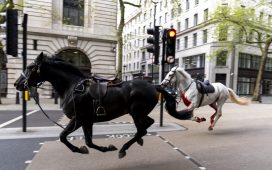We are in the Surrey Hills and praying the weather holds. Last week was a washout – the rain incessant and the clouds low and fast-moving like smoke blown from a fire.
This spot is said to be one of the best in the south-east for hawfinches – our largest finch but one of the hardest to see.
Our vantage point is Dick Focks Common, a squelchy schlep up from Sheepleas Car Park in Forestry Commission land near East Horsley. It overlooks private woods towards Sheepwalk Lane.
It’s been an hour and nothing so far.
Then, there, one at first – then two more, another one, two and three – in bouncing flight and coming into land at the top of the tallest of those larches among the firs on that ridge 300 yards off.
And good grief, look at the size of its head, it’s massive – as if someone has taken the front end of one bird and joined it to the back of another. A cut-and-shut finch, if you will.
The bill is equally oversized – a pyramid on its face. It’s a bill used to crack cherry stones and the like using a force of 150psi. That’s a huge amount of pressure for such a small animal. A car tyre is inflated to a little over 30psi.
The plumage is muted in this shy winter light but the overall impression is of a ginger orange head, a silver-grey scarf or shawl thrown over a brown coat, white wing bars and a white tip to the black tail. That’s the male – the female is the same just less ginger.
A thick black line running around each eye and over the bill gives a stern expression.
This time of year is the best time to see hawfinches. Resident numbers are increased by winter visitors from northern Europe and the reduced amount of foliage makes them easier to spot as they perch in the tree canopies.
A great-spotted woodpecker joins our birds on the larches across the way. A flock of half a dozen brambling, too – winter visitors that are northern cousins to our resident chaffinch.
The light fades yet further and there is a growing drizzle in the air. The hawfinches no less unmistakeable for being just outlines in the gloom – top heavy and that oversized bill. Soon they will go into roost so we squelch back down the hill as the drizzle turns to rain.
MORE : Nature Calls: New Year, new bird-watching list
MORE : Nature Calls: Scoping out Sheppey for Britain’s smallest bird of prey














